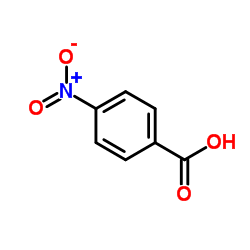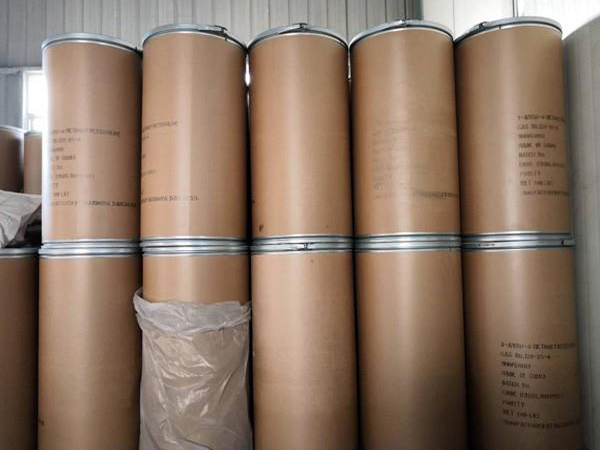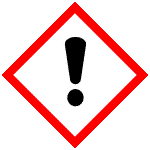4-Nitrobenzoic acid

Common Name | 4-Nitrobenzoic acid | ||
CAS Number | 62-23-7 | Molecular Weight | 167.119 |
Density | 1.5±0.1 g/cm3 | Boiling Point | 359.1±25.0 °C at 760 mmHg |
Molecular Formula | C7H5NO4 | Melting Point | 237-240 °C(lit.) |
Structural formula |  | Flash Point | 166.5±11.6 °C |
Symbol | GHS07 | Signal Word | Warning |

Name | 4-nitrobenzoic acid |
Synonym | More Synonyms |

Density | 1.5±0.1 g/cm3 |
Boiling Point | 359.1±25.0 °C at 760 mmHg |
Melting Point | 237-240 °C(lit.) |
Molecular Formula | C7H5NO4 |
Molecular Weight | 167.119 |
Flash Point | 166.5±11.6 °C |
Exact Mass | 167.021851 |
PSA | 83.12000 |
LogP | 1.89 |
Vapour Pressure | 0.0±0.8 mmHg at 25°C |
Index of Refraction | 1.615 |
Stability | Stable. Combustible. Incompatible with strong oxidizing agents, cyanides, strong bases. |
Water Solubility | <0.1 g/100 mL at 26 oC |

CHEMICAL IDENTIFICATION
RTECS NUMBER :DH5075000
CHEMICAL NAME :Benzoic acid, p-nitro-
CAS REGISTRY NUMBER :62-23-7
LAST UPDATED :199701
DATA ITEMS CITED :26
MOLECULAR FORMULA :C7-H5-N-O4
MOLECULAR WEIGHT :167.13
WISWESSER LINE NOTATION :WNR DVQ
HEALTH HAZARD DATA
ACUTE TOXICITY DATA
TYPE OF TEST :Standard Draize test
ROUTE OF EXPOSURE :Administration into the eye
SPECIES OBSERVED :Rodent - rabbit
TYPE OF TEST :LD50 - Lethal dose, 50 percent kill
ROUTE OF EXPOSURE :Oral
SPECIES OBSERVED :Rodent - rat
DOSE/DURATION :1960 mg/kg
TOXIC EFFECTS :Sense Organs and Special Senses (Eye) - lacrimation Behavioral - convulsions or effect on seizure threshold
TYPE OF TEST :LD50 - Lethal dose, 50 percent kill
ROUTE OF EXPOSURE :Intraperitoneal
SPECIES OBSERVED :Rodent - rat
DOSE/DURATION :1210 mg/kg
TOXIC EFFECTS :Sense Organs and Special Senses (Eye) - lacrimation Behavioral - convulsions or effect on seizure threshold
TYPE OF TEST :LD50 - Lethal dose, 50 percent kill
ROUTE OF EXPOSURE :Parenteral
SPECIES OBSERVED :Rodent - rat
DOSE/DURATION :1960 mg/kg
TOXIC EFFECTS :Sense Organs and Special Senses (Eye) - lacrimation Behavioral - convulsions or effect on seizure threshold
TYPE OF TEST :LD50 - Lethal dose, 50 percent kill
ROUTE OF EXPOSURE :Intraperitoneal
SPECIES OBSERVED :Rodent - mouse
DOSE/DURATION :880 mg/kg
TOXIC EFFECTS :Behavioral - somnolence (general depressed activity) Behavioral - convulsions or effect on seizure threshold Behavioral - aggression
TYPE OF TEST :LD50 - Lethal dose, 50 percent kill
ROUTE OF EXPOSURE :Intravenous
SPECIES OBSERVED :Rodent - mouse
DOSE/DURATION :770 mg/kg
TOXIC EFFECTS :Behavioral - somnolence (general depressed activity) Behavioral - convulsions or effect on seizure threshold Behavioral - aggression
TYPE OF TEST :LD50 - Lethal dose, 50 percent kill
ROUTE OF EXPOSURE :Parenteral
SPECIES OBSERVED :Rodent - mouse
DOSE/DURATION :1470 mg/kg
TOXIC EFFECTS :Behavioral - somnolence (general depressed activity) Behavioral - convulsions or effect on seizure threshold Behavioral - aggression
TYPE OF TEST :TDLo - Lowest published toxic dose
ROUTE OF EXPOSURE :Oral
SPECIES OBSERVED :Rodent - rat
DOSE/DURATION :11760 mg/kg/14D-C
TOXIC EFFECTS :Blood - normocytic anemia Blood - methemoglobinemia-carboxyhemoglobin Nutritional and Gross Metabolic - weight loss or decreased weight gain
TYPE OF TEST :TDLo - Lowest published toxic dose
ROUTE OF EXPOSURE :Oral
SPECIES OBSERVED :Rodent - rat
DOSE/DURATION :10400 mg/kg/13W-C
TOXIC EFFECTS :Kidney, Ureter, Bladder - changes in tubules (including acute renal failure, acute tubular necrosis) Blood - changes in spleen
TYPE OF TEST :TDLo - Lowest published toxic dose
ROUTE OF EXPOSURE :Oral
SPECIES OBSERVED :Rodent - mouse
DOSE/DURATION :56 gm/kg/14D-C
TOXIC EFFECTS :Liver - changes in liver weight Endocrine - changes in thymus weight
TYPE OF TEST :TDLo - Lowest published toxic dose
ROUTE OF EXPOSURE :Oral
SPECIES OBSERVED :Rodent - mouse
DOSE/DURATION :11050 mg/kg/13W-C
TOXIC EFFECTS :Nutritional and Gross Metabolic - weight loss or decreased weight gain
TYPE OF TEST :TDLo - Lowest published toxic dose
ROUTE OF EXPOSURE :Oral
SPECIES OBSERVED :Rodent - rat
DOSE/DURATION :45063 mg/kg/2Y-C
TOXIC EFFECTS :Tumorigenic - neoplastic by RTECS criteria Skin and Appendages - tumors
MUTATION DATA
TYPE OF TEST :Sister chromatid exchange
TEST SYSTEM :Rodent - hamster Ovary
DOSE/DURATION :1 gm/L
REFERENCE :
ENMUDM Environmental Mutagenesis. (New York, NY) V.1-9, 1979-87. For publisher information, see EMMUEG. Volume(issue)/page/year: 9,269,1987 *** OCCUPATIONAL EXPOSURE LIMITS *** OEL-RUSSIA:STEL 2 mg/m3 JAN 1993 *** NIOSH STANDARDS DEVELOPMENT AND SURVEILLANCE DATA *** NIOSH OCCUPATIONAL EXPOSURE SURVEY DATA : NOHS - National Occupational Hazard Survey (1974) NOHS Hazard Code - 83217 No. of Facilities: 32 (estimated) No. of Industries: 2 No. of Occupations: 3 No. of Employees: 396 (estimated) NOES - National Occupational Exposure Survey (1983) NOES Hazard Code - 83217 No. of Facilities: 3573 (estimated) No. of Industries: 31 No. of Occupations: 46 No. of Employees: 42700 (estimated) No. of Female Employees: 12407 (estimated)

Symbol |
GHS07 |
Signal Word | Warning |
Hazard Statements | H302-H319 |
Precautionary Statements | P305 + P351 + P338 |
Personal Protective Equipment | dust mask type N95 (US);Eyeshields;Gloves |
Hazard Codes | Xn:Harmful |
Risk Phrases | R22 |
Safety Phrases | S26-S39-S24/25 |
RIDADR | NONH for all modes of transport |
WGK Germany | 1 |
RTECS | DH5075000 |
HS Code | 29163900 |

Use 1: Used as a chemical reagent.
Use 2: It is used as a pharmaceutical intermediate, and it is also a raw material for the production of dyes.
Use 3: It is used for the preparation of anesthetic procaine hydrochloride and dye intermediates, as well as for the preparation of filters, and also for the production of photosensitive materials, the production of photosensitive materials and the electric paste in capacitors.
Use 4: It is used to synthesize procaine, procaine amide, p-aminobenzoic acid, folic acid, etc. It is also widely used to synthesize pesticides and fuels.
Use 5: Test alkaloids, standardize standard alkali solutions.





